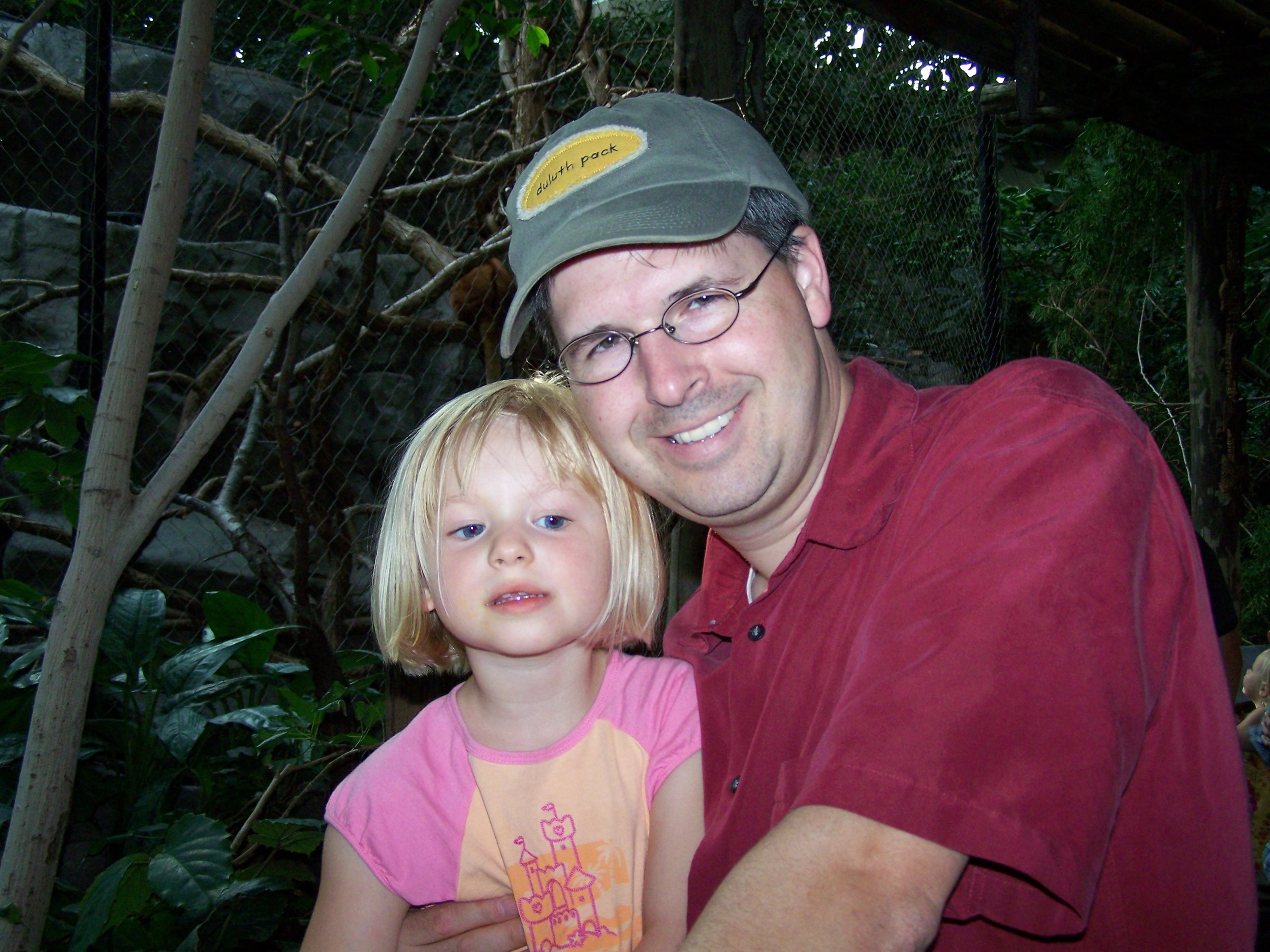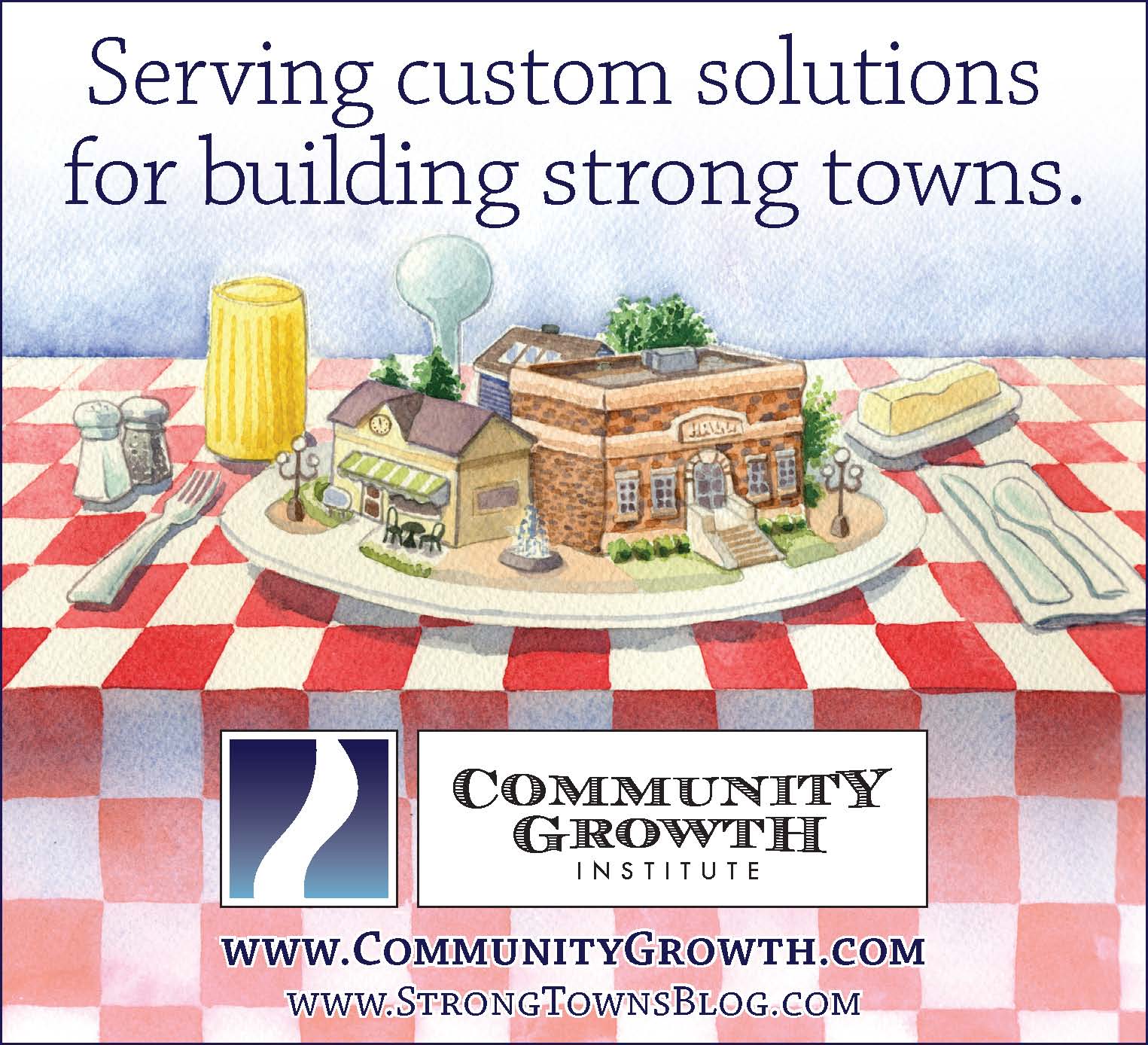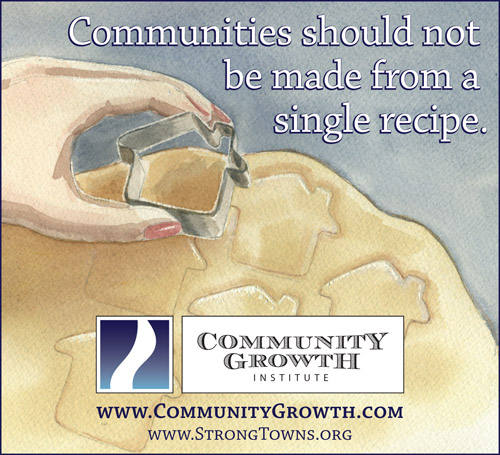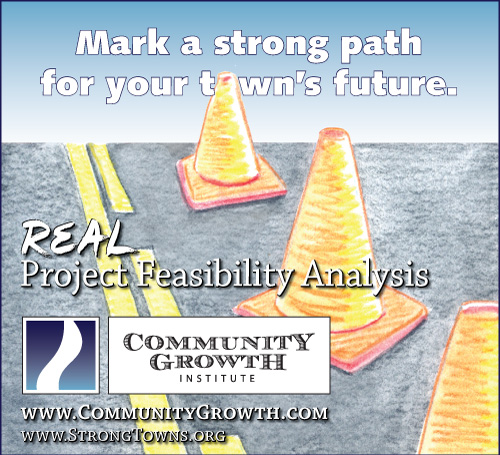A Decade of Strong Towns - Year 1
This is the tenth year of Strong Towns and, as we head towards our official anniversary in November, I’ve been asked to reflect on how we got here. I’ll do so a year at a time. This month I’m going back to the very beginning – 2008 – and talk about how this movement got started.
Chuck with daughter Chloe on vacation in San Diego, 2008.
I wish I could say that Strong Towns is what I planned from the start, that a rapidly growing international movement for positive change in our cities, towns and neighborhoods was the original vision. Sadly, it wasn’t.
I’ve joked many times that writing the blog that became Strong Towns was cheaper than therapy. I joke, but it’s not far from the truth. I started writing here in November of 2008 because I didn’t know what else to do. I was angry, frustrated and disillusioned with the world around me, a world that didn’t make any sense, one that was falling apart on many levels in ways that seemed, for me, both easy to comprehend yet incomprehensible to everyone around me.
And I’m very serious here: I thought I might be a little crazy. My wife has a saying she uses often: “If everyone around you seems crabby, it’s probably you that’s crabby.” It’s a practical and helpful insight. A modified version of this frequently crossed my mind in 2008: if the entire world seemed crazy to me — and it did — perhaps it was me who was crazy.
Back to School
In 2000, I had quit my comfortable and secure job as (and I’m being modest here, but it’s true) somewhat of a rising star in a successful and growing engineering firm. I went back to graduate school for a planning degree thinking I would become a better engineer. Instead, I wound up understanding just how bad of an engineer I was and how clueless I had been in my chosen profession. I became convinced that what the small towns and rural areas I worked with needed more than anything wasn’t a better engineer. What they needed was something resembling a competent planner.
Those places started to call, and I decided to answer those calls. By the time I finished my coursework at the University of Minnesota’s Humphrey Institute, I had started my own planning firm and had hired a couple of my classmates to help me do planning work for more than a dozen cities, all by word of mouth.
There is an enormous competence gap in the planning being done for small towns. Most of it is filled by engineers—professionals who get their paycheck from doing large projects mostly with state and federal money. I had been one of them, but if you'd asked me in my engineering days, I would have denied that my recommendations were at all self-serving. And while I certainly didn't intend them to be, as an engineer, I had a very small toolbox of options at my disposal—nearly all of which, incidentally, were designed to bring in those big state and federal dollars.
My goal with my planning firm was to change the way planning was done in rural America. That was literally our mission statement. I hired great planners and trained them in the small town context, which is very different than the urban/suburban places where they were used to working. I figured out a way to get these great planners out into rural cities at a price those communities could afford. I created programs for training decision-makers, for keeping their codes and plans up to date, and for improving public engagement over time.
We put everything online in an age when cities, especially small towns, were deathly afraid of being online. We were freakishly transparent, obsessively accurate and well-respected for our professionalism. And internally, we were just as dedicated to improving what we did. One year, instead of an end-of-year Christmas party, I took those funds and flew the entire planning staff down to Orlando for a whirlwind tour of New Urbanist designs— designs we knew were important, but weren’t seeing here in rural Minnesota. We tried hard to continually get better.
This all happened during the housing boom. By 2006, we had five offices and we were working with over 75 cities. I had some great business partners, a successful and growing organization, and our work was making things better in a lot of places that would otherwise be neglected, if not outright exploited.
The Crash
Then it all unraveled. Before you can foreclose on a home (2008), you have to default on the home (2007), you have to build the home (2006) and you have to get a permit for the home (2005). The peak year for us was 2005. We wrote more permits, worked on more new developments and did more planning and ordinance writing in that year than we would ever do again. The next year it collapsed. By the end of 2006, we were down to two offices and there were just four of us (and a pile of cash flow debt) remaining. It was the apocalypse.
“I was warning our cities that things were going to get difficult, that we had overbuilt and created a huge mess for ourselves... That didn’t go over well.”
Prior to 2006, I had been doing some basic financial analysis for the cities we worked with, mostly looking at specific projects that were particularly crazy. By the end of 2006, I was Chicken Little crying about the sky falling to anyone who would give me an audience. I was warning our cities that things were going to get difficult, that we had overbuilt and created a huge mess for ourselves. I had compelling data to back up my claims. I did not have any answers beyond recommending we stop doing what we were doing, regroup and ready ourselves for hard times.
This didn’t go over well. Certainly, part of it was that I came across as a fanatic — someone who can’t change their mind and won’t change the subject — but part of it was also that stopping was not possible. Things were getting bad and the other professionals the city retained—if not the elected officials—could sense that. My advice to stop — stop building more roads, accepting new developments, adding new pipe, growing! — was a threat to everyone else in the system.
People would pull me aside and tell me to either stop being negative or just stop talking completely. When I recommended we not provide an $800,000 subsidy to a big box store on the edge of town, one that would directly compete with our small businesses in our core downtown, I had one city council member (a long-time supporter) email me and ask, “Why are you trying to hurt the city?”
(L to R) Chuck and colleagues James Lehnoff and Beth Elliott documenting shoreline conditions for a research project for one of our cities.
I’ve never been afraid to stand alone in a crowd. Some people may think that is an admirable trait; it sometimes is, but frequently is not. Yet, more and more, I truly was being forced to. I stopped getting invited to meetings where people didn’t want uncomfortable questions asked. My firm stopped being invited to submit proposals for work. And, ultimately, when things did start to go bad everywhere, ending the contract with the crank consultant instead of laying off the loyal and hardworking staff member was the easy and obvious choice for many.
By the end of 2008, my dreams of making a living transforming rural America were shattered. I had a mound of business debt greater than my mortgage which, like many Americans, was also now underwater. I had failed my business partners and the communities I served. I had unfairly — even selfishly — endangered the economic security and future for my wife and kids. What a disaster!
And add to this the disaster going on around all of us. Most of our younger readers think of 2008 in historical terms as the year Barack Obama was elected to the White House. That was the hope and change amid a lot of tumult.
By the end of 2007, the subprime housing crisis was starting to spread. Banks were starting to wobble, as was the broader stock market. I didn’t predict the housing crisis, but by this point I could tell that everybody talking about it — from Ben Bernanke to to George W. Bush to Barack Obama and on down — had no clue what they were talking about. At least they didn’t understand what was obvious to me: We had overbuilt by a ton, what we built was unproductive junk and our cities were insolvent as a result. From where I sat, it looked like it was all going down hard.
When the treasury department engineered a bailout of Bear Stearns, I already owned a handful of put options on Citibank — a crazy investment akin to gambling that I would not do again today — because I thought (incorrectly) that they were the weakest bank. They ultimately didn't fail before the bailout money rolled in, but my gamble worked out anyway because all the banks cratered in price, including Citibank.
“We weren’t going to make the same mistakes they made in the Great Depression. No, we were going to make new ones.”
That summer, gas was over $4 per gallon. The local school district, which had just built a new middle school out in the middle of nowhere, was getting killed on busing costs. My reporter wife did a story on hypermilers — people who seek to maximize their fuel efficiency with their driving techniques — and I started to see them everywhere. For the first time, gas prices were threatening long commutes. Anyone who owned a Hummer (a status car in my part of the world), could hardly give it away.
That fall, everything went bad. Lehman Brothers collapsed, which threatened the entire house of cards. Bailouts were engineered at unimaginable scale, the losers propped up in a manner both reckless and immoral, with the nearly unanimous support of the ruling class. (The Tea Party and, later, Occupy Wall Street, were the only ones truly objecting). The Federal Reserve bought an insurance company named AIG that had written rainy day insurance policies either believing there would never be a rainy day or — more likely — knowing they would get huge bonuses up until it rained, at which time they would need a bailout (or just abandon their clients in their hour of need).
Oh, and their clients were a bunch of crooked bankers who were taking advantage of the cheap insurance to goose their own bonuses while they sold your pension fund a bunch of toxic securities they knew would fail but had rigged to be rated AAA. Fun times.
A city council meeting in Garrison, MN
My office at the time was in the basement of a local bank, the kind that got hammered from every direction and didn’t get any bailouts. I watched the panic there every day as failed developments (some I had worked on) were defaulted on and they suddenly found themselves the owners of messes worth much less than what they had into them. I watched many good — and some not-so-good — lives destroyed. It was painful for a lot of people.
And at the climax, in October and early November of the election season, when banks were failing and bailouts were being engineered, all I could hear were the politicians and economists calling for us to get back to what we all knew worked: more infrastructure, more construction jobs and more of what I was seeing slowly bankrupt the cities I had worked with. Everyone was demanding it. Barack Obama was promising it.
We weren’t going to make the same mistakes they made in the Great Depression. No, we were going to make new ones.
I was angry. I was disillusioned. I felt professionally isolated, like I carried a contagious disease. I was alone, and I didn’t know what to do. So I started to write.
Beginning to Write
Jim Kunstler describes writing as a self-emergent phenomenon. It’s a way of ordering one’s thoughts coherently. I promised myself I would write three days a week the same way someone dedicated to exercise will pledge themselves to a regular schedule. That was my response, my way of making sense of the craziness around me.
I initially called my blog theplannerblog.com; the concept of a Strong Town would be developed over the coming months. If you read those early pieces, they are pretty pathetic. I read them now and find that I was still the guy trying to fix the planners and the engineers. I still believed that the problems we faced could be solved simply by professionals acting differently.
“I promised myself I would write three days a week the same way someone dedicated to exercise will pledge themselves to a regular schedule. That was my response, my way of making sense of the craziness around me.”
My first article was a quasi-defense of a project I would not defend today. My second questioned the American Planning Association’s efforts to promote the importance of planners as people instead of planning as a profession (I still believed in the profession at that point). A couple days before Christmas, I wrote What’s the Matter with Engineers and took my first steps towards describing the Growth Ponzi Scheme.
The current economic crisis is likely to hit local governments hard in the coming years. It will be important to watch and see how communities react. I suspect there will be those who "double down" on their current development pattern, investing even more in infrastructure to entice new development. The state and federal governments may even fund some of that spending. This is a road to ruin, but one that will likely be advocated for by those in the engineering profession. It's not that they are self-serving. I think the opposite - they genuinely want to make things better. The problem is just that they have a very limited toolbox.
There are a few people I need to note as major influences and collaborators in those early years. The main one, of course, is my mentor George Orning. George nudged me towards graduate school, was very influential in helping me think through my planning firm, introduced me to my business partner, and shaped my thinking on these issues in innumerable ways. If I look back at this time period and point to one person who changed my life’s trajectory, it is George.
Of course, the crew at Community Growth Institute (my business) was also critical. My business partner and close associate, Ben Oleson, who intellectually helped (and tolerated me) with some of the crazier ideas. He still does the same work today and Central Minnesota is better for it.
Some of my other colleagues, especially Ruurd Schoolderman, Lisabeth Barajas, James Lehnoff and Jennifer Schillcox have gone on to do important work. I’m very proud of them and grateful to have had the opportunity to work with them. Justin Burslie is still a close friend, a neighbor and colleague on the Brainerd Planning Commission and is continuing the work of Community Growth Institute at his position with the National Joint Powers Alliance.
I also need to acknowledge some major influences going into that first year: the people I had not met. The first is a Minnesota Twins blogger named Aaron Gleeman. A guy who didn’t finish college and who wasn’t accepted as a writer to the University of Minnesota's newspaper — the Minnesota Daily (a distinction he shares with my brilliant and well-accomplished journalist wife) — was writing his own blog with the freshest new take out there on my favorite team. He’s gone on to become the editor of the hugely influential Baseball Prospectus, but at the time he was writing each day literally out of his mom’s basement. I wanted to do for my professions what I saw him doing for baseball. I stole his concept for a Friday link-o-rama, which I renamed the Friday News Digest, easily the most popular thing I routinely wrote in those days. I am still a passionate follower of his work.
At this point too, I was also neck deep in the prominent New Urbanist writers, specifically Andres Duany and James Kunstler. I had not yet attended a Congress for the New Urbanism, but I had watched every YouTube video and read every book by the pair. It would be a couple of years yet until I got to know each of them, but by the end of 2008, their work had already answered so many questions for me.
In my article next month, I’ll take you through 2009 — the first full year of blogging, the development of the Strong Towns concept, the rebranding of the site and the launching of Strong Towns as an organization.








Charles Marohn (known as “Chuck” to friends and colleagues) is the founder and president of Strong Towns and the bestselling author of “Escaping the Housing Trap: The Strong Towns Response to the Housing Crisis.” With decades of experience as a land use planner and civil engineer, Marohn is on a mission to help cities and towns become stronger and more prosperous. He spreads the Strong Towns message through in-person presentations, the Strong Towns Podcast, and his books and articles. In recognition of his efforts and impact, Planetizen named him one of the 15 Most Influential Urbanists of all time in 2017 and 2023.